| Listing 1 - 10 of 17 | << page >> |
Sort by
|
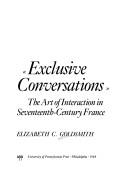
ISBN: 0812281020 9780812281026 Year: 1988 Publisher: Philadelphia (Pa.): University of Pennsylvania press,
Abstract | Keywords | Export | Availability | Bookmark
 Loading...
Loading...Choose an application
- Reference Manager
- EndNote
- RefWorks (Direct export to RefWorks)
French literature --- Conversation in literature. --- Social interaction in literature. --- Courtesy in literature. --- Salons
Book
ISBN: 0814270999 0814211410 9780814211410 Year: 2010 Publisher: Columbus : Ohio State University Press,
Abstract | Keywords | Export | Availability | Bookmark
 Loading...
Loading...Choose an application
- Reference Manager
- EndNote
- RefWorks (Direct export to RefWorks)
Cognition in literature. --- Social perception in literature. --- Social interaction in literature. --- Fiction --- Narration (Rhetoric) --- History and criticism. --- Technique. --- Narrative (Rhetoric) --- Narrative writing --- Rhetoric --- Discourse analysis, Narrative --- Narratees (Rhetoric) --- Fiction writing --- Metafiction --- Writing, Fiction --- Authorship --- Fiction - Technique --- Fiction - History and criticism --- Social interaction in literature --- Social perception in literature --- Cognition in literature
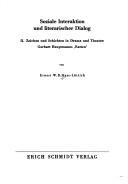
ISBN: 3503012907 9783503012909 Year: 1985 Volume: 98 Publisher: Düsseldorf Schmidt
Abstract | Keywords | Export | Availability | Bookmark
 Loading...
Loading...Choose an application
- Reference Manager
- EndNote
- RefWorks (Direct export to RefWorks)
830 "19" HAUPTMANN, GERHART --- Social problems in literature --- Social interaction in literature --- Duitse literatuur--20e eeuw. Periode 1900-1999--HAUPTMANN, GERHART --- Hauptmann, Gerhart --- 830 "19" HAUPTMANN, GERHART Duitse literatuur--20e eeuw. Periode 1900-1999--HAUPTMANN, GERHART --- Hauptmann, Gerhardt --- Hauptmann, Gerhart,
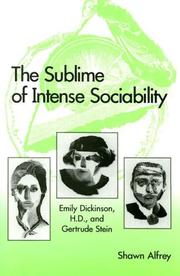
ISBN: 0838754023 Year: 2000 Publisher: Lewisburg (Pa.) : Bucknell university press,
Abstract | Keywords | Export | Availability | Bookmark
 Loading...
Loading...Choose an application
- Reference Manager
- EndNote
- RefWorks (Direct export to RefWorks)
American literature --- Modernism (Literature) --- Social interaction in literature. --- Socialization in literature. --- Sublime, The, in literature. --- Women and literature --- Women authors --- History and criticism. --- History --- H. D. --- Dickinson, Emily, --- Stein, Gertrude, --- Criticism and interpretation. --- Criticism and interpretation. --- Criticism and interpretation.
Book
ISBN: 9781501315763 Year: 2016 Publisher: New York London Bloomsbury Academic
Abstract | Keywords | Export | Availability | Bookmark
 Loading...
Loading...Choose an application
- Reference Manager
- EndNote
- RefWorks (Direct export to RefWorks)
"Throughout his literary work Goethe portrays characters who defy and reject Enlightenment ideals of the bourgeois family, notions of heritage, assumptions about biological connections, expectations about heterosexuality, and legal mandates concerning marriage. The questions Goethe's plays and novels pose are often modern and challenging: Do social conventions, family expectations, and legal mandates matter? Can two men or two women pair together and be parents? How many partners or parents should there be? Two? One? A group? Can parents love children not biologically related to them? Do biological parents always love their children? What is the nature of adoptive parents, children, and families? Ultimately, what is the fundamental essence of love and family? Gustafson demonstrates that Goethe's conception of the elective affinities is certainly not limited to heterosexual spouses or occasionally to men desiring men. A close analysis of Goethe's explication of affinities throughout his literary production reveals his rejection of loveless relationships (for example, arranged marriages) and his acceptance and promotion of all relationships formed through spontaneous affinities and love (including heterosexual, same-sex, bisexual, group, parental, and adoptive)"-- "An analysis of all the radical love relationships (heterosexual, same-sex, bisexual, biological, and adoptive) that Goethe portrays throughout his literary works"--
Love in literature. --- Families in literature. --- Social interaction in literature. --- LITERARY CRITICISM / General. --- LITERARY CRITICISM / European / German. --- LITERARY CRITICISM / Gay & Lesbian. --- Goethe, Johann Wolfgang von --- Goethe, Johann Wolfgang von --- Characters. --- Criticism and interpretation.
Book
ISBN: 9780814211410 9780814292402 Year: 2010 Publisher: Columbus, Ohio Ohio State University Press
Abstract | Keywords | Export | Availability | Bookmark
 Loading...
Loading...Choose an application
- Reference Manager
- EndNote
- RefWorks (Direct export to RefWorks)
Sociology of literature --- Fiction --- Literary rhetorics --- Psychological study of literature --- Narration (Rhetoric) --- Social interaction in literature --- Social perception in literature --- Cognition in literature --- Technique --- History and criticism --- Cognition in literature. --- Social interaction in literature. --- Social perception in literature. --- History and criticism. --- Technique. --- 82-3 --- 82:316 --- Proza. Fictie. Narratologie --- Literatuursociologie --- 82:316 Literatuursociologie --- 82-3 Proza. Fictie. Narratologie --- Narration (Rhetoric). --- 82-3 Fiction. Prose narrative --- Fiction. Prose narrative
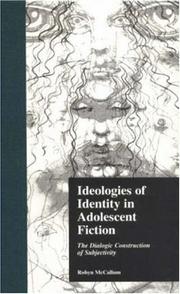
ISBN: 1282778943 9786612778940 1135581304 0203900952 9780203900956 9780815322900 0815322909 9781135581305 9781135581251 1135581258 9781135581299 1135581290 9780415858021 041585802X 0815322909 Year: 1999 Publisher: New York Garland Pub.
Abstract | Keywords | Export | Availability | Bookmark
 Loading...
Loading...Choose an application
- Reference Manager
- EndNote
- RefWorks (Direct export to RefWorks)
Ideologies of Identity in Adolescent Fiction examines the representation of selfhood in adolescent and children's fiction, using a Bakhtinian approach to subjectivity, language, and narrative. The ideological frames within which identities are formed are inextricably bound up with ideas about subjectivity, ideas which pervade and underpin adolescent fictions. Although the humanist subject has been systematically interrogated by recent philosophy and criticism, the question which lies at the heart of fiction for young people is not whether a coherent self exists but what kind of self i
Young adult fiction --- Children's stories --- Subjectivity in literature. --- Self in literature. --- Identity (Psychology) in literature. --- Social interaction in literature. --- Fiction --- Narration (Rhetoric) --- Narrative (Rhetoric) --- Narrative writing --- Rhetoric --- Discourse analysis, Narrative --- Narratees (Rhetoric) --- Fiction writing --- Metafiction --- Writing, Fiction --- Authorship --- Young adult literature --- History and criticism. --- Technique. --- Children --- Narration (Rhetoric). --- Youth --- Books and reading. --- børne- og ungdomslitteratur.
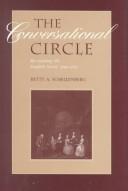
ISBN: 0813159075 9780813159072 0813119901 9780813119908 0813185238 9780813185231 Year: 1996 Publisher: Lexington, Ky University Press of Kentucky
Abstract | Keywords | Export | Availability | Bookmark
 Loading...
Loading...Choose an application
- Reference Manager
- EndNote
- RefWorks (Direct export to RefWorks)
The Conversational Circle offers a model for exploring a range of novels that experiment with narrative patterns. It makes a compelling case that teleological approaches to novel history that privilege the conflict between the individual and society are, quite simply, ahistorical. Twentieth-century historians of the early novel, most prominently Ian Watt, Mikhail Bakhtin, and Terry Castle, have canonized fictions that portray the individual in sustained tension with the social environment. Such fictions privilege a strongly linear structure. Recent reexaminations of the canon, however, have r
Families in literature. --- Speech in literature. --- Friendship in literature. --- Social interaction in literature. --- Oral communication in literature. --- Domestic fiction, English --- Literature and society --- Conversation in literature. --- English fiction --- Family in literature --- History and criticism. --- History --- Fiction --- Sociology of literature --- English literature --- anno 1700-1799
Book
ISBN: 1443846341 9781443846349 1443842427 9781443842426 9781443846349 Year: 2013 Publisher: Newcastle upon Tyne Cambridge Scholars
Abstract | Keywords | Export | Availability | Bookmark
 Loading...
Loading...Choose an application
- Reference Manager
- EndNote
- RefWorks (Direct export to RefWorks)
Filling a gap in the literature on communities, this innovative and critical volume proposes the concept of Cocoon Communities. Cocoon communities are highly significant for its members and yet not binding. Membership is voluntary and informal. Weaving together interdisciplinary perspectives, the contributors offer theoretical perspectives and research findings on communities of international students, online mourners, farmworkers, expatriates, and 'Westerners' in India. The volume will be of...
Communities. --- Community life. --- Associations, institutions, etc. --- Human ecology --- Community --- Social groups --- Communities --- Communities in literature --- Social interaction in literature --- #SBIB:39A11 --- #SBIB:39A6 --- 316.47 --- Community in literature --- 316.47 Sociale relaties --(sociologie) --- Sociale relaties --(sociologie) --- Antropologie : socio-politieke structuren en relaties --- Etniciteit / Migratiebeleid en -problemen
Book
ISBN: 9780813928098 9780813928142 0813928141 0813928095 1280490543 9781280490545 9786613585776 6613585777 Year: 2009 Publisher: Charlottesville, Va University of Virginia Press
Abstract | Keywords | Export | Availability | Bookmark
 Loading...
Loading...Choose an application
- Reference Manager
- EndNote
- RefWorks (Direct export to RefWorks)
Whereas scholars of the period have generally read the coquette as a simple and self-evident type, Our Coquettes emphasizes what is strange and surprising about this figure, revealing the coquette to be a touchstone in developing discourses about sexuality, consumerism, empire, and modernity itself. Winner of the Walker Cowen Memorial Prize for an outstanding work of scholarship in eighteenth-century studies.
Thematology --- English literature --- anno 1700-1799 --- Literature and society --- Young women --- Consumption (Economics) --- Consumption (Economics) in literature. --- Man-woman relationships in literature. --- Social interaction in literature. --- Flirting in literature. --- Young women in literature. --- Women --- Young adults --- Girls --- Consumer demand --- Consumer spending --- Consumerism --- Spending, Consumer --- Demand (Economic theory) --- History --- Social life and customs --- History and criticism.
| Listing 1 - 10 of 17 | << page >> |
Sort by
|

 Search
Search Feedback
Feedback About UniCat
About UniCat  Help
Help News
News